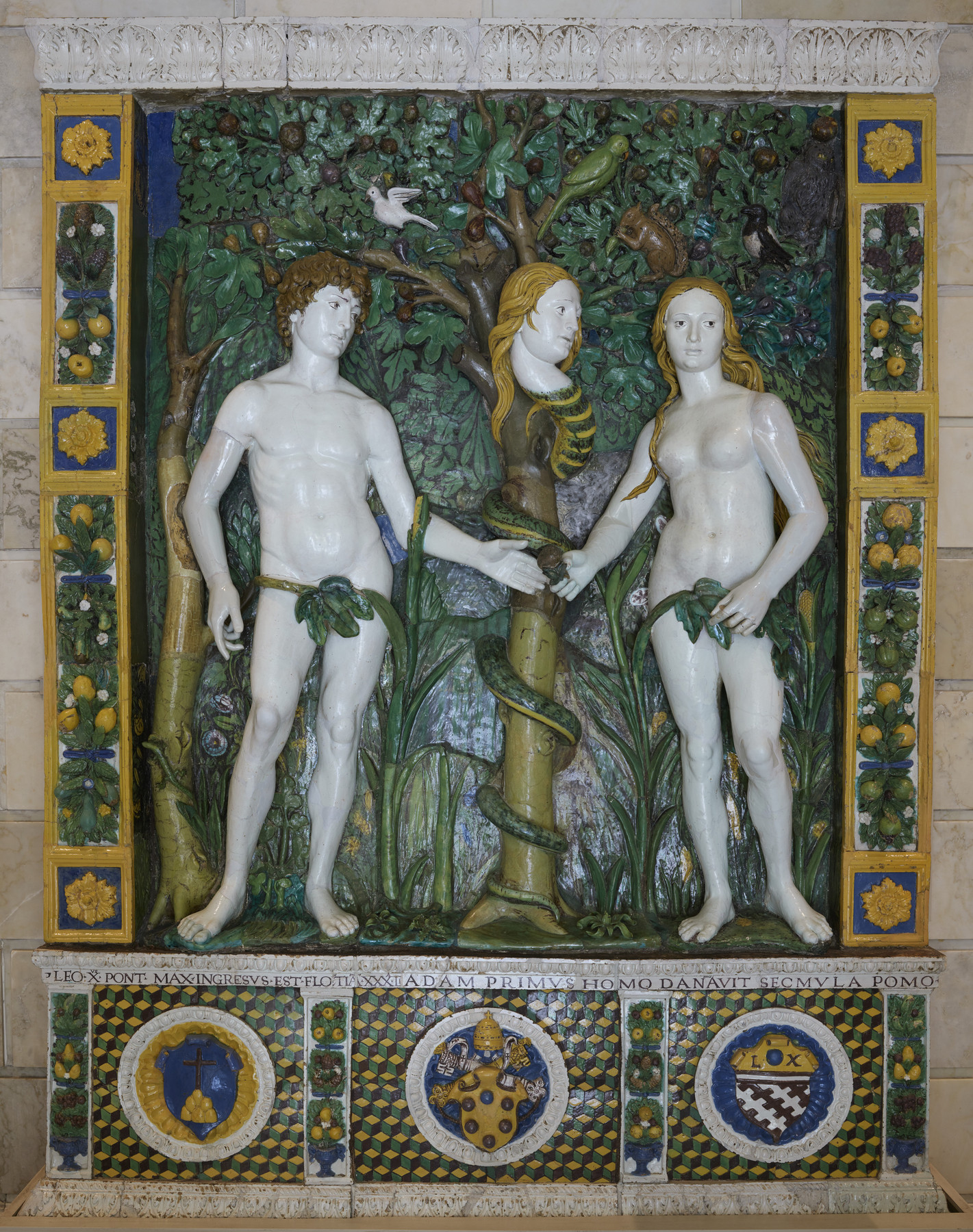Adam and Eve
(Renaissance Europe )
The first two humans are depicted with ideal bodies that recall ancient marble sculptures. The snake has a woman's face that resembles Eve's. In the Middle Ages Church scholars suggested that the devil may have induced Eve to listen to him because he took on the appearance of a young woman so that would be comfortable having a chat. During this period, women were often described as ignorant and untrustworthy, features which this story reflects. The primary visual source for the compostion is an engraving representing Adam and Eve by the German master Albrecht Dürer and dated 1504. Besides the figures, the engraving features a dense wall of forest foliage that has been taken over by the sculptor to create a rich backdrop in relief for his figures. The German master populated the underbrush with a variety of animals, which in the sculture have been greatly reduced in number. Nevertheless, there is one detail that has tantalized scholars. The tall plants with yellow heads of grain have been interpretated by some as corn or maize from the Americas. This would indeed be remarkably early for their inclusion in European imagery; nevertheless, recent techncal examinations have concluded that the passages where this appears to be the clearest is in fact a replacement from the 1800s.
The incomplete inscription on the basesuggests that this is one of the many works of art made in Florence to celebrate the triumphal entrance of Pope Leo X, a member of Florence's Medici family, into the city on November 30, 1515. However this cannot be substantiated. The central coat of arms is the pope's. To the right is that of the Salviati family, and to the left is that of the Buondelmonti family, demonstrating their support of the pope.
For several generations, the artists of the Della Robbia family in Florence were noted for the production of brightly colored, glazed terracottas, often produced for architectural settings. These are the first nudes in this new techniques.
Provenance
Provenance (from the French provenir, 'to come from/forth') is the chronology of the ownership, custody, or location of a historical object. Learn more about provenance at the Walters.
Mme Camille Lelong, Paris; Lelong Collection Sale, Paris, 1902, no. 98; purchased by Henry Walters, Baltimore, 1902; by bequest to Walters Art Museum, 1931 .
Conservation
| Date | Description | Narrative |
|---|---|---|
| Treatment | This object was cleaned to remove dirt and grime, as well as reduce prior restoration materials that were covering original ceramic surfaces. The object was examined and analyzed to answer questions as to its authenticity and extent of prior restoration. Several broken fragments were repaired, and old painted restorations were toned to better match the original. | |
| Treatment | repaired | |
| Examination | Examined for condition, surfaces cleaned of dust and grime. | |
| Examination | Examined to determine stability; loose joins reinforced with adhesive. | |
| Treatment | Cleaned, examined, repaired. | |
| Examination | Examined, cleaned | |
| Examination | Examined, repaired. | |
| 12/10/1958 | Treatment | repaired |
| 8/14/1959 | Treatment | repaired |
| 4/21/1960 | Treatment | repaired |
| 11/1/1972 | Treatment | cleaned |
| 10/1/1973 | Treatment | cleaned |
| 4/1/1974 | Treatment | cleaned; repaired; loss compensation |
| 3/1/1988 | Treatment | cleaned; coated; loss compensation; other |
| 3/16/1988 | Examination | examined for condition |
| 7/6/1998 | Examination | examined for condition |
| 1/1/2003 | Treatment | cleaned |
Geographies
Italy, Florence (Place of Origin)
Measurements
H: 110 1/16 x W: 83 7/16 in. (279.5 x 212 cm)
Credit Line
Acquired by Henry Walters, 1902
Location in Museum
Accession Number
In libraries, galleries, museums, and archives, an accession number is a unique identifier assigned to each object in the collection.
In libraries, galleries, museums, and archives, an accession number is a unique identifier assigned to each object in the collection.
27.219




